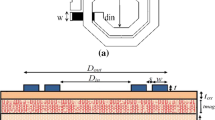Abstract
This paper presents the design of a square planar spiral inductor, to integrate it into a DC–DC converter. The process of dimensioning of this integrated inductor has led us to identify all geometric parameters that are linked by a set of equations dedicated to this topology and to resolution of problems related to the substrate (skin effect, effect proximity, etc.). The equivalent electrical model adopted of the integrated inductor takes into account all the technological parameters which are described by analytic expressions. The results of different simulations concern the influence of geometry on the inductance value, on the different technological parameters and finally on its quality factor. In order to validate our dimensioning, we conducted simulations on the operating of our converter containing initially a conventional inductor and then a integrated inductor. Simulation results have shown that the waveforms of the current and output voltage in both cases are similar. This demonstrated the proper sizing of our integrated inductor.
































Similar content being viewed by others
References
Lopez-Villegas JM, Samitier J, Bausells J, Merlos A, Cané C, Knochel R (1997) Study of integrated RF passive components performed using CMOS and Si micromachining technologies. J Micromech Microeng 7:162–164
Burns LM (1998) Integrated circuit technology options for RFIC’s-present status and future directions. IEEE J Solid State Circuits 33:387–399
Estibals B, Sanchez J-L, Alonso C, Camonet H, Laur J-P (2003) Vers l’intégration de convertisseurs pour l’alimentation des microsystems. J3eA, Journal sur l’enseignement des sciences et technologies de l’information et des systèmes 2(Hors–Sèrie 2):5
Ribas RP, Lescot J, Leclercq J-L, Karam JM, Ndagijimana F (2000) Micromachined microwave planar spiral inductors and transformers. IEEE Trans Microw Theory Tech 48(8):1326–1326. doi:10.1109/22.859477
Tang CC, Wu CH, Liu SI (2002) Miniature 3-D inductors in standard CMOS process. IEEE J Solid State Circuits 37(4):471–480
Lu H-C, Chan TB, Chen CC-P, Liu C-M, Hsing H-J, Huang P-S (2010) LTCC spiral inductor synthesis and optimization with measurement verification. IEEE Trans Adv Packag 33(1):160–168. doi:10.1109/TADVP.2009.2028636
Melati R, Hamid A, Thierry L, Derkaoui M (2013) Design of a new electrical model of a ferromagnetic planar inductor for its integration in a micro-converter. Math Comput Model 57(3):200–227
Haddad E, Martin C, Joubert C, Allard B, Soueidan M, Lazar M, Buttay C, Payet-Gervy B (2011) Modeling, fabrication, and characterization of planar inductors on YIG substrates. In: Soueidan M, Roumié M, Pierre M (eds) Advanced materials research. Trans Tech Publications 324:294–297
Guettaf Y, Rizouga M, Hamid A (2015) Design and modeling of a square planar inductor for a push pull converter. J Electr Electron Eng 8(1):17–22
Eroglu A (2011) Planar inductor design for high power applications. Prog Electromagn Res B 35:53–67
Martin C, Allard B, Tournier D, Soueidan M, Rousseau JJ, Allassem D, Menager L, Bley V, Lembeye JY (2009) Planar inductors for high frequency DC–DC converters using microwave magnetic material. In: IEEE ECCE, pp 1890–1894
Musunuri S, Chapman PL, Zou J, Liu C (2005) Design issues for monolithic DC–DC converters. IEEE Trans Power Electron 20:639–649
Estibals B, Alonso C, Salles A, Schanen JL, Perret R (2001) Validation d’outils de simulation d’éléments inductifs pour convertisseur statique integé. IEE Eng Sci Educ J 10(5):197–205
Karaarslan A (2016) The implementation of bee colony optimization control method for interleaved converter. Electr Eng 98:109–119
Allaoui A, Hamid A, Spiteri P, Bley V, Lebey T (2015) Thermal modeling of an integrated inductor in a micro-converter. J Low Power Electron 11(1):63–73
Pacurar C, Topa V, Munteanu C, Racasan A, Hebedean C (2013) Studies of inductance variation for square spiral inductors using CIBSOC software. Environ Eng Manag J 12:1161–1169
Ammouri A, Belloumi H, Salah TB (2014) Experimental analysis of planar spiral inductors. CISTEM 2014:1–5
Miranda CM, Pichorim SF (2015) Self-resonant frequencies of air-core single-layer solenoid coils calculated by a simple method. Electr Eng 97:57–64
Talwalkar NA, Yue CP, Wong SS (2005) Analysis and synthesis of on-chip spiral inductors. IEEE Trans Electron Devices 52(2):176–182
Yue CP, Ryu C, Lau J, Lee TH, Wong SS (1996) A physical model for planar spiral inductors on silicon. In: Electron devices meeting, IEDM ’96, international, pp 155–158
Spanik P, Frivaldsky M, Drgona P, Cuntala J, Glapa N (2014) Design procedure of simple and accurate model of electric double layer capacitor (EDLC) targeting fast verification purposes of heat transfer simulations. Electr Eng 96:121–134
Oh NJ, Lee S (2006) A simple model parameter extraction methodology for an on-chip spiral inductor. ETRI J 28(1):115–118
Yue CP, Wong SS (2000) Physical modeling of spiral inductors on silicon. IEEE Trans Electron Devices 47(3):560–567
Costa EMM (2009) Parasitic capacitances on planar coil. J Electromagn Waves Appl 23:2339–2350
Mohan SS, Hershenson M, Boyd SP, Lee TH (1999) Simple accurate expressions for planar spiral inductances. IEEE J Solid State Circuits 34(10):1419–1424
Chiou MH, Hsu KYJ (2006) A new wideband modeling technique for spiral inductors. IET Microw Antennas Propag 151:115–120
François Leplus MHEl, TP d’électrotechnique par simulation préparation manipulation et solution par PSIMDEMO avec énergies renouvelables, 2nd edn. Book ellipses
Author information
Authors and Affiliations
Corresponding author
Rights and permissions
About this article
Cite this article
Guettaf, Y., Flitti, A., Bensaci, A. et al. Simulation of the operation of a DC–DC converter containing an inductor of planar type. Electr Eng 100, 953–969 (2018). https://doi.org/10.1007/s00202-017-0558-7
Received:
Accepted:
Published:
Issue Date:
DOI: https://doi.org/10.1007/s00202-017-0558-7




